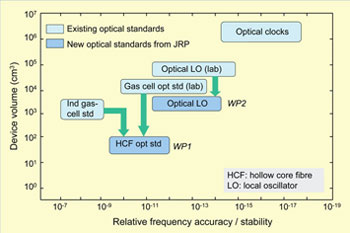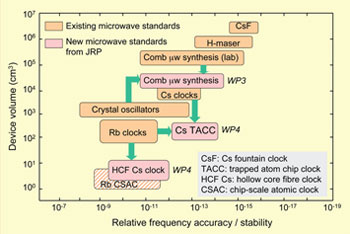Challenges
- Frequency standards underpin society's increasing demand for fast, high capacity information transfer
- Applications span defence, security, aerospace, transportation, and communications sectors
- For remote and often-moving locations, frequency standards must be robust, small and have low power consumption, without excessive loss of accuracy
State of the art
Optical
- Frequency standards used in optical communications will become inadequate as ITU channel spacings decrease and spectral coverage increases
- Improved optical local oscillators are required for characterizing the spectral properties of new laser sources for telecommunications
Microwave
- Precision quartz oscillators suffer from drift and aging, and their stability is limiting for some applications, e.g. radar
- Commercial Cs clocks are too large for mobile use, and not accurate enough for some future applications, e.g. in the defence industry
Click on image to enlarge
Impact
Financial
- Compact and portable industrial frequency standards are key for a wide range of European markets, including defence, navigation, telecommunications, instrument manufacturing and gas sensing
- Reduced European dependency on external suppliers, e.g. from the USA
Social
- Improved frequency standards will extend autonomous operation of safety-critical location-based services
- New frequency standards are critical to meeting ever-growing demand for faster internet access and data transfer
Environmental
- New frequency standards for atmospheric gas monitoring, leading to improved understanding of climate change
Standardisation
- Inputs to development of International Electrotechnical Commission (IEC) and International Telecommunications Union (ITU) standards
For more information: Patrick Gill


